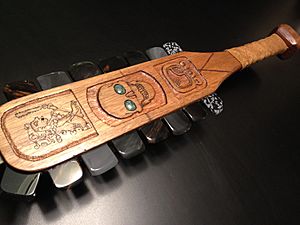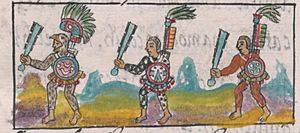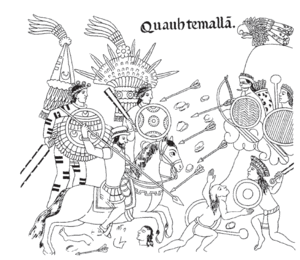Macuahuitl facts for kids
Quick facts for kids Macuahuitl |
|
|---|---|

A modern recreation of a ceremonial macuahuitl
|
|
| Type | Macuahuitl |
| Place of origin | Mexico |
| Service history | |
| In service | Classic to Post-Classic stage (900–1570) |
| Used by | Mesoamerican civilizations, including Aztecs Indian auxiliaries of Spain |
| Wars | Aztec expansionism, Mesoamerican wars Spanish conquest of the Aztec Empire |
| Specifications | |
| Mass | 2.0–3.0 kg (4.4–6.6 lb) |
| Length | 90–120 cm (35–47 in) |
|
|
|
| Blade type | Straight, thick, double-edged, tapered |
| Hilt type | Double-handed swept |
| Scabbard/sheath | Unknown |
| Head type | Trapezoidal |
| Haft type | Straight, wood covered by leather |
The macuahuitl ([maːˈkʷawit͡ɬ]) was a special weapon used long ago. It was a wooden club with sharp blades made of obsidian stuck into its sides. The name comes from the Nahuatl language and means "hand-wood."
Obsidian is a type of volcanic glass. It can be made incredibly sharp, even sharper than modern steel razor blades! This made the macuahuitl a very powerful weapon for close-up fighting.
People started using the macuahuitl around the year 1000 CE. By the time the Spanish arrived in the Americas, this weapon was common. Many different groups in Mesoamerica used it. This included the Aztecs, Maya, Mixtec, and Toltec peoples.
Only one original macuahuitl survived the Spanish conquest of the Aztec Empire. It was kept in the Royal Armoury of Madrid until a fire destroyed it in 1884. We know what it looked like from old drawings and descriptions.
Contents
What Was the Macuahuitl Like?
The macuahuitl was a key weapon for the Aztec army and other groups in central Mexico. Spanish explorers saw it during their conquest in the 1500s. Other Aztec military gear included round shields, bows, and spear-throwers.
The sides of the macuahuitl had many sharp blades. These blades were made from obsidian, a type of volcanic glass. Obsidian can be sharpened to an edge that is even sharper than a steel razor.
This weapon could cause very serious cuts. The obsidian blades were either shaped like sharp points or round scales. The macuahuitl was not exactly a sword or a club. It was more like a "saw sword," as one historian described it.

A Spanish explorer named Bernal Díaz del Castillo said the macuahuitl was about 0.9 to 1.2 meters (3 to 4 feet) long. It was about 7.5 centimeters (3 inches) wide. It had grooves along its edges where the sharp obsidian pieces were glued in.
Historian John Pohl says most were just over a meter long. Some larger ones were made to be used with both hands. The obsidian pieces were about 3 centimeters (1.2 inches) long. They were attached to the wooden paddle with a natural glue called bitumen.
Sometimes the obsidian blades were spaced out. Other times, they were placed very close together to form a continuous edge. The Spanish noted that the blades were so well-made they could not be easily pulled out or broken. Macuahuitls came in different shapes. Some were rectangular, others oval, or pointed. They also had either one-handed or two-handed grips. Some two-handed macuahuitls were as tall as a person!
Different Types of Macuahuitl
An archaeologist named Marco Cervera Obregón has studied these weapons. He believes there were two main types:
- The macuahuitl: This was about 70 to 80 centimeters (27 to 31 inches) long. It had six to eight obsidian blades on each side.
- The mācuāhuitzōctli: This was a smaller club, about 50 centimeters (20 inches) long. It had only four obsidian blades.
Where Did They Come From?

The macuahuitl was used even before the Aztecs. Early people in Mesoamerica used tools made from obsidian. Obsidian was also used for knives, sickles, and arrow points.
Many obsidian mines were near the Aztec lands in the Valley of Mexico. One area was even called the Sierra de las Navajas (Razor Mountains) because of its obsidian.
Ancient carvings show warriors holding macuahuitls. For example, a carving at Chichen Itza shows a warrior with a club that has separate blades sticking out.
By the time the Spanish arrived, the macuahuitl was used widely across Mesoamerica. The Aztecs, Mixtecs, and Toltecs all used it. Native fighters who helped the Spanish also used macuahuitls. However, they often preferred Spanish metal swords. European swords gave them more respect among both Europeans and other native peoples.
How Effective Was It?
The macuahuitl had some weaknesses compared to European steel swords. Even though obsidian is sharper, it is also more fragile than steel. Obsidian blades could break when hitting other obsidian blades, steel swords, or metal armor. They also struggled to cut through European chain mail.
The thin, replaceable blades could become dull or chipped if they hit bone or wood many times. This meant warriors had to be very skilled to use the weapon well. Swinging a club takes more time and space than thrusting with a sword. So, warriors fought in open formations, often one-on-one.
Testing the Macuahuitl Today
People have made copies of the macuahuitl to see how well they worked. These tests have been shown on TV shows like the History Channel and Discovery Channel.
On the show Warriors, a special forces soldier accidentally cut his leg while using a macuahuitl. This showed how sharp and dangerous the weapon was.
On the show Deadliest Warrior, a replica was tested on a model of a horse's head. The model was made from a horse's skeleton and a special gel. An actor was able to cut off the model's head, but it took three swings. The macuahuitl was most effective when it was swung and then dragged backward, creating a sawing motion. Because of this, one computer programmer on the show called it "the obsidian chainsaw."
See also
 In Spanish: Macuahuitl para niños
In Spanish: Macuahuitl para niños

